Early learning and childcare at age five: comparing two cohorts
A report on early learning and childcare use and provision in Scotland, comparing Growing Up in Scotland data from 2008-09 and 2014.
3 Early Learning and Childcare
3.1. Introduction
As noted in the introductory chapter, ELC provision in Scotland has undergone a number of changes in recent years and continues to be high on the political agenda. This chapter considers the characteristics of ELC use among 4 year olds in 2014/15, comparing this with use six years previously.
In line with key policy debates, the chapter first examines the average number of hours children in each of the two GUS birth cohorts attended their main ELC provider at the time they were aged around 4 years old. [22] Specifically, the chapter also explores whether there were any signs of any change in ELC attendance following the increase in entitlement (from 475 hours to 600 hours per year) which was available from August 2014. It also considers how attendance differs according to children's social background and where they live. Moving on to consider the ELC setting, the chapter then looks at the type of ELC providers attended by 4 year old children in each of the cohorts. Following this, using data from the Care Inspectorate, consideration is given to the quality of the ELC providers attended by the cohort children. Finally, the chapter examines how characteristics of the ELC setting - provider type and quality - differ according to measures of children's social background and by location.
3.2. Key findings
- Among children who attended ELC (97% of children in BC1; 98% children in BC2), on average, 4 year olds in 2014 spent just over two hours per week longer in ELC compared with 4 year olds in 2008/09, [23] namely 16.6 hours on average per week compared with 14.4 hours per week.
- In both 2008/09 and 2014, children in more advantaged circumstances tended to spend longer hours in ELC than their less advantaged peers. For example, in 2014, on average, children living in households in the lowest income quintile spent just over 15 hours per week at their main ELC provider, while those in the highest income quintile spent an average of 20 hours per week. These differences increased between the cohorts. Children living in urban areas also attended ELC for longer hours than those in rural areas and towns. [24]
- The analysis showed an increase in average parent-reported ELC use for 4 year old children following the increase in entitlement introduced in August 2014. On average, parents who were interviewed in the six months before the increase in entitlement reported that their child spent 15.3 hours per week in ELC compared with 17.0 hours per week reported by parents who were interviewed in the six months after the increase. [25]
- The most common type of ELC provider attended by children in each of the two cohorts was a local authority-run nursery class attached to a primary school. In both cohorts, children in higher income households were more likely than those in lower income households to attend a private or voluntary ELC provider. This difference was more pronounced in BC2 than in BC1.
- In both cohorts, children living in disadvantaged circumstances were just as likely as their more advantaged peers to attend an ELC provider which achieved high grades across all four quality themes assessed by the Care Inspectorate.
- However, children in more deprived areas were less likely than those in less deprived areas to attend an ELC provider with a high staffing quality grade (as assessed by the Care Inspectorate). Between 2008/09 and 2014 the proportion of children attending a setting with a high staffing quality grade increased across all deprivation groups. However, it appears to have increased more in areas with the lowest levels of deprivation.
3.3. ELC attendance
As noted in section 1.3, an extension of the entitlement to funded ELC provision for 3 and 4 year olds and eligible 2 year olds came into force in August 2014 - from 475 hours per year to 600 hours per year, spread across a period of 38 weeks. Information about ELC (pre-school) attendance was collected from families in BC1 in 2008/09 when the children were around 4 years old. Corresponding information was collected from families in BC2 in 2014 and 2015. This means that for children in BC1 information about ELC attendance was collected while the entitlement was 475 hours per year. Conversely, for many children in BC2 information on ELC attendance was collected after the increase in entitlement; that is, when the entitlement was 600 hours per year. That said, for some children in BC2 ELC attendance information was collected before the policy change; that is, while the entitlement was still 475 hours per year. Specifically, this applies to BC2 children for whom ELC information was collected before August 2014. On the one hand, this means that comparisons of ELC attendance across the cohorts do not lend themselves easily to assessments of the effect of the increase in entitlement. On the other hand, it means that it is possible to compare - using data from BC2 - average ELC attendance among 4 year olds where the interview took place in the six months before the increase in entitlement, with ELC attendance among 4 year olds where the interview took place in the six months after the increase in entitlement. Comparisons of this nature will be of particular relevance to policy makers and others interested in examining the potential effects of increasing ELC entitlement.
It is important to note that the way information about average ELC duration was collected varied slightly within and between the cohorts and the original measures of ELC attendance were not directly comparable across cohorts and age points. Therefore, the results must be interpreted with caution. In both cohorts, and at all age points, parents were asked to give an estimate of the amount of time the child would typically spend at their main ELC provider. However, while in BC1 parents were asked to provide a weekly estimate, in BC2 parents were asked to give an estimate for each day of the week, with estimates provided either to the nearest half hour, the nearest ten minutes, or the nearest minute. To enable comparison, these measures were combined into a single composite measure of the amount of time a child spent at their main ELC provider in an average week to the nearest half hour. Further details about the ELC attendance data are provided in Appendix A.
Also, as noted in section 2.2, the measure of ELC used in this report refers specifically to time a child spent at the setting where they received 'pre-school education', that is, time spent at their main ELC provider (including both funded and unfunded hours). As such, references to ELC do not include any childcare a child received from other providers (e.g. childminders providing wrap-around childcare). Where applicable, this is referred to as 'childcare' rather than ELC.
3.3.1. ELC attendance across the two cohorts
The vast majority of children in both BC1 and BC2 attended ELC at some point around the time they were 4 years old. Children in BC2 were a little more likely to have attended ELC than children in BC1: 97% of children in BC1 had attended ELC since their 3 rd birthday compared with 98% in BC2.
Furthermore, among all children who attended ELC, children in BC2 attended their main ELC provider for a higher number of hours per week than children in BC1. On average, children in BC1 attended ELC for 14.4 hours per week, whereas children in BC2 attended ELC for an average of 16.6 hours per week. At the time where ELC data were collected, just under two thirds of children in BC2 were entitled to 600 hours of funded ELC per year, [26] while the remaining third of children in BC2 and all children in BC1 were entitled to 475 hours per year.
The general increase in the number of hours children spent at their main ELC provider is further demonstrated in Figure 3-1. The graph shows that the proportion of children who attended ELC for less than 12.5 hours per week decreased from 30% in BC1 to 10% in BC2, and the proportion of children who attended ELC for 12.5 hours per week decreased from 40% to 22%. Meanwhile, the proportion of children who attended ELC for more than 12.5 but less than 16 hours per week increased from 15% to 42%, and the proportion of children who attended for between 16 and 30 hours per week increased from 10% to 20%. The proportion of children who attended ELC for 30 or more hours per week stayed the same.
Figure 3‑1 Average weekly duration of attendance at main ELC provider, by cohort

Base: All cases where child attended ELC and information about average weekly number of hours was provided. Base sizes (unweighted/weighted): BC1 = 3731/3720, BC2 = 4306/4304.
3.3.2. Duration of attendance at ELC and childcare from other providers
It is useful to consider how ELC use was combined with childcare from other providers ('childcare'). Figure 3-2 shows a breakdown of weekly average childcare and ELC use for children in BC1 and BC2. [27] It shows that, in both cohorts, care provided by their main ELC provider made up a substantial proportion of the total amount of childcare and ELC a child received - half of all childcare for children in BC1 (50%) and just over half of all childcare in BC2 (55%). It also shows a number of differences between the cohorts. For example, there was a small increase in the average number of hours children attended a group-based childcare provider other than their main ELC provider (from 4.6 hours in BC1 to 5.7 hours in BC2), and a small drop in the average number of hours spent in informal care (from 7.7 to 6.4 hours per week). Overall, between 2008/09 and 2014, there was an increase not only in the time 4 year old children spent at their main ELC provider, but also in the time spent in other group-based care and in the overall time they spent in non-parental care.
Figure 3‑2 Average weekly duration of attendance at ELC/childcare, by provider type and by cohort
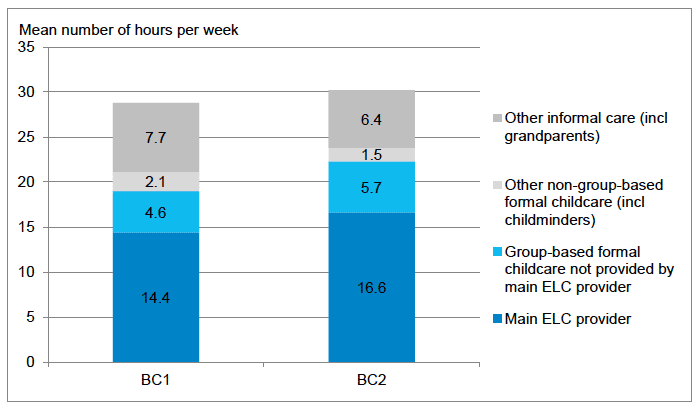
Base: All cases where child attended ELC and information about average weekly number of hours of ELC and other childcare provision was provided. Base sizes (unweighted/weighted): BC1 = 3731/3720, BC2 = 4291/4291. All differences between the cohorts shown in the chart were statistically significant at p<.001.
Figure 3-3 shows a further breakdown of weekly average use of childcare and ELC for children in BC2, by the average number of hours they spent at their main ELC provider. It shows some differences in use of other childcare providers according to time spent at the main ELC provider. Most prominently, it indicates that children who spent relatively long hours at their main ELC provider (30 hours or more per week) also tended to spend relatively long hours in another group-based setting (16.1 hours per week on average). While these averages cover a range of children in different circumstances, the figures suggest that, on average, this relatively small group of children (around 6% of all 4 year olds in 2014) spent as much as 58 hours per week being cared for by someone other than their parent(s) or carer(s). [28]
Figure 3‑3 Average weekly duration of attendance at range of ELC and childcare providers, by average weekly duration of attendance at main ELC provider - BC2 only
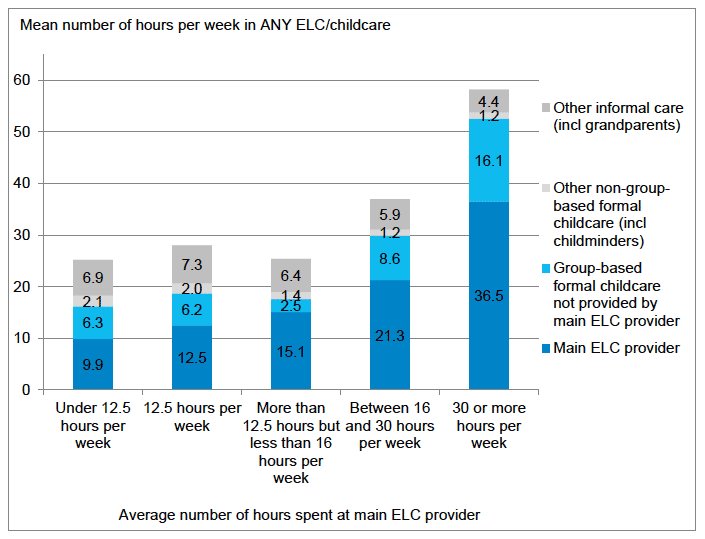
Base: All BC2 cases where child attended ELC and information about average weekly number of hours was provided for ELC and other childcare provision. Base sizes (unweighted/weighted): Under 12.5 hours per week = 436/413, 12.5 hours per week = 894/939, More than 12.5 but less than 16 hours per week = 1776/1814, Between 16 and 30 hours per week = 904/862, 30 or more hours per week = 296/276.
3.3.3. Duration of attendance at main ELC provider: comparing families interviewed before and after the increased entitlement in 2014
The analysis also compared weekly ELC use among BC2 families who were interviewed before and after the changes to ELC entitlement came into place in August 2014. Specifically, the average weekly duration of attendance at the child's main ELC provider among children whose families were interviewed in the six months before the increased entitlement came into place was compared with the duration of attendance among children whose families were interviewed in the six months after the increase. Given the differences in how data on weekly ELC attendance were collected before and after the policy change, these results must be interpreted with caution (see Appendix A for further details).
On average, children whose families were interviewed in the six months after the increase in entitlement attended their main ELC provider for a higher number of hours per week than those whose families were interviewed in the six months before the increase in entitlement: 17.0 compared with 15.3. [29]
3.3.4. Variations in duration of ELC attendance by socio-economic and area characteristics
The increase in time spent in ELC between the cohorts (from an average of 14.4 to an average of 16.6 hours per week, as noted above) was evident across all socio-economic groups. Nonetheless, in both cohorts, the average weekly number of hours children attended ELC varied by socio-economic characteristics and location. This is in line with results from earlier analysis of GUS data (Bradshaw et al., 2014). As shown in Figure 3-4, among children in BC2 the number of hours children spent in ELC increased with household income. Furthermore, the difference in weekly ELC attendance between children in the lowest and highest income households increased between the cohorts - from 2.6 hours in BC1 to 4.7 hours in BC2.
Figure 3‑4 Average weekly duration of attendance at main ELC provider, by equivalised annual household income and by cohort
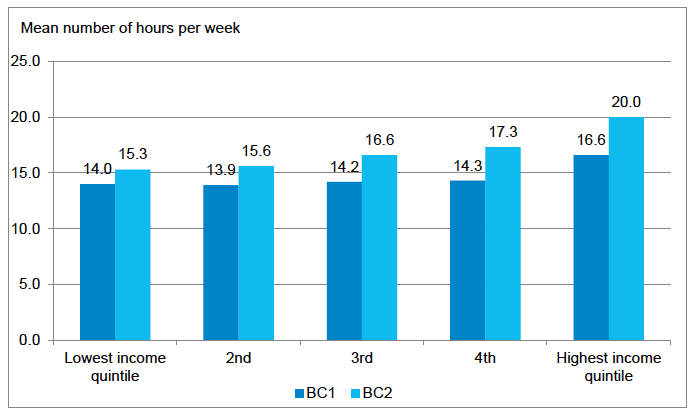
Base: All cases where child attended ELC and information about duration of ELC attendance was provided. Base sizes (unweighted/weighted): BC1 = 3731/3720, BC2 = 4306/4304.
In both cohorts, children whose parents had higher levels of education also spent a higher number of hours in ELC than children whose parents had lower levels of education. The difference between children whose parents had higher and lower levels of education increased between the cohorts. As can be seen in Figure 3-5, among children in BC1 the difference in weekly ELC attendance between children whose parents were educated to degree level and children whose parents had lower standard grades or below was 1.1 hours. Among children in BC2 this difference had risen to 2.2 hours.
Figure 3‑5 Average weekly duration of attendance at main ELC provider, by highest level of parental education and by cohort
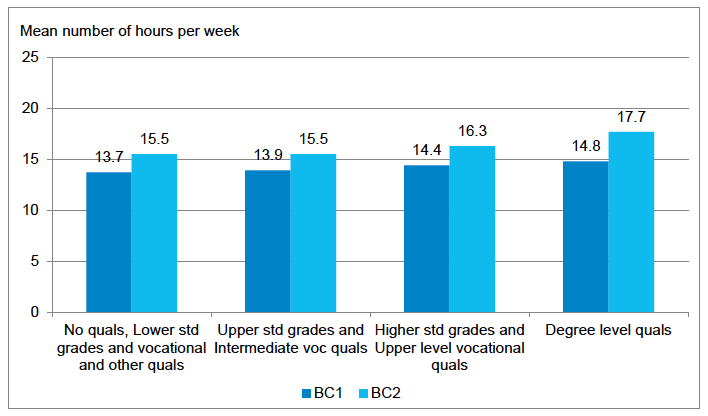
Base: All cases where child attended ELC and information about duration of ELC attendance was provided. Base sizes (unweighted/weighted): BC1 = 3731/3720, BC2 = 4306/4304.
Weekly ELC attendance also varied according to the level of area deprivation. In BC2, as shown in Figure 3-6, children in the less deprived quintiles spent a higher number of hours in ELC than children in more deprived quintiles, with those in the least deprived quintile spending an average of 1.8 hours more in ELC per week than those in the most deprived quintile. In BC1, the pattern was different; on average, BC1 children living in the most and least deprived quintiles attended ELC for longer hours than children in the middle three quintiles. Thus, the difference in weekly ELC attendance between children in the most and least deprived areas increased between the cohorts.
Figure 3‑6 Average weekly duration of attendance at main ELC provider, by level of area deprivation ( SIMD) and by cohort
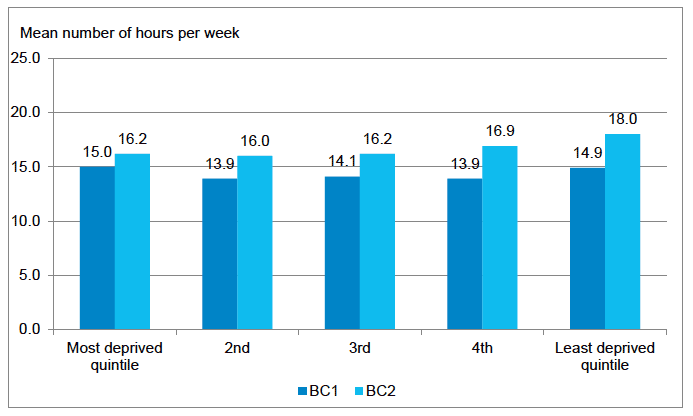
Base: All cases where child attended ELC and information about duration of ELC attendance was provided. Base sizes (unweighted/weighted): BC1 = 3731/3720, BC2 = 4306/4304.
Finally, BC2 children living in urban areas attended ELC for a higher number of hours than children living in towns or rural areas. Children living in urban areas spent an average of 17.2 hours per week in ELC compared with 15.3 hours for children living in towns and 15.7 for children living in rural areas. This pattern was similar to that seen in BC1. [30]
3.4. The ELC setting
This section looks at characteristics of the ELC settings attended by children in each of the two GUS cohorts. It looks first at the type of ELC provider using the survey data. Second, drawing on data from the Care Inspectorate, it considers the quality ratings of the ELC providers attended by children in each of the cohorts. Third, it considers how these aspects of ELC settings differ according to socio-economic characteristics, area deprivation and urban/rural location.
3.4.1. Provider type
As part of the GUS interview parents were asked to provide details about the cohort child's main ELC provider, including the type of provider. The following categories were used in the analysis:
- 'Local authority nursery class': nursery classes attached to a local authority-run primary school
- 'Other local authority providers': local authority nursery schools or nursery centres not attached to a primary school, local authority playgroups and family centres
- 'Private and voluntary providers': private day nurseries or nursery schools, nursery classes attached to an independent/private school, private playgroups, community/voluntary nurseries, and community/voluntary playgroups.
The majority of children in both cohorts (62%) attended a local authority nursery class attached to a primary school (Table 3-1). The remainder were split between private and voluntary sector providers (21% in BC1; 23% in BC2) and other forms of local authority-run ELC settings (18% in BC1; 15% in BC2). Whilst the figures seem to suggest that children in BC2 were slightly more likely than those in BC1 to attend private and voluntary providers and a little less likely to attend other local authority settings, this difference was not statistically significant.
Table 3‑1 ELC provider type, by cohort
| BC1 | BC2 | |
|---|---|---|
| Base: All children who attended ELC and where information about provider type was provided. | % | % |
| Local authority nursery class attached to primary school | 62 | 62 |
| Other local authority settings | 18 | 15 |
| Private and voluntary providers | 21 | 23 |
| Unweighted bases | 3731 | 4314 |
| Weighted bases | 3720 | 4311 |
No significant difference between the cohorts.
3.4.2. Provider quality
This section compares average quality grades for the ELC settings attended by children in the two cohorts, drawing on data from the Care Inspectorate. Average quality grades from a period of three years (2008-2010 for BC1; 2013-2015 for BC2) were calculated for each of the following quality themes: care and support, environment, staffing, and leadership and management. [31] For each individual theme, the proportion of children who attended a provider with either a 'very good' or 'excellent' grade was derived. In addition, an overall measure of cross-theme quality - 'grading mix'- was derived. This measure indicates whether or not a provider achieved 'very good' or 'excellent' ratings across all four quality themes. [32]
The proportion of children in each cohort who attended an ELC setting with a grade of at least 'very good' on each of the individual themes assessed by the Care Inspectorate is shown in Figure 3-7. The figure also shows the proportion of children who attended a provider which achieved at least a grade of 'very good' across all four themes.
Figure 3‑7 Proportion of children attending ELC provider with at least 'very good' grade on individual quality themes and across all four quality themes, by cohort
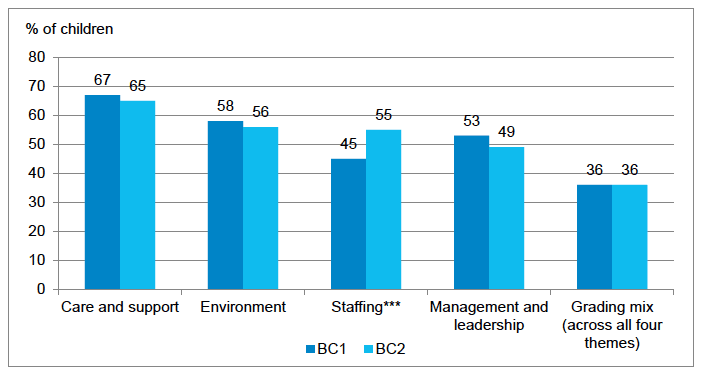
Bases: All cases where the child attended ELC and where Care Inspectorate quality information was obtained. Base sizes (unweighted/weighted): BC1: Care and support = 3118/3095, Environment = 3013/2976, Staffing = 3103/3081, Management and leadership = 2998/2963, Grading mix = 2818/2775. BC2: Care and support = 3941/3953, Environment = 3941/3953, Staffing = 3941/3953, Management and leadership = 3941/3953, Grading mix = 3941/3953.
*** significant difference between the cohorts at p<.001 level.
Figure 3-7 shows that children in BC2 were more likely than children in BC1 to attend an ELC provider with 'very good' or 'excellent' staffing grades (55% compared with 45%). However, the proportion of children who attended an ELC provider which achieved 'very good' or 'excellent' grades across all four quality measures was the same in both cohorts (36%). The apparent differences between the cohorts on other measures were not statistically significant.
Existing research has pointed to some differences in quality between types of ELC settings. For example, a report from the EPPE study noted that the variation in quality was particularly large among private providers (Sylva et al., 2004). In the Scottish context, a recent analysis by the Care Inspectorate which looked at the full range of ELC providers in Scotland suggested that, on average, the quality of local authority settings was higher than for private and voluntary sector providers (Care Inspectorate, 2016). Such differences are also reflected in the GUS data. As illustrated in Figure 3-8, in both cohorts around three in ten (28% in BC1; 29% in BC2) children in private or voluntary settings attended a provider with high quality grades across all four measures, compared with around four in ten (39% in BC1; 38% in BC2) children who attended a local authority nursery class.
It is also worth noting that the proportion of children who attended a provider with a high staffing quality grade increased across all provider types between cohorts, but particularly for children attending private/voluntary providers and other local authority providers. [33]
Figure 3‑8 Proportion of children attending ELC setting with 'very high' or 'excellent' score across all four quality themes, by provider type and by cohort
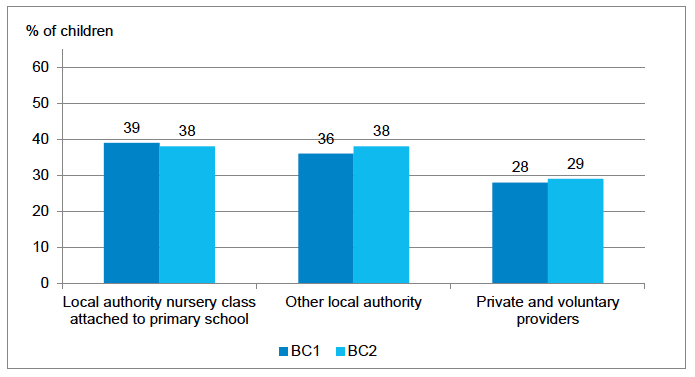
Bases: All cases where the child attended ELC and where information about provider type and Care Inspectorate quality was obtained. Base sizes (unweighted/weighted): BC1: Local authority nursery class attached to primary school = 1728/1709, Other local authority = 433/455, Private and voluntary providers = 657/611. BC2: Local authority nursery class attached to primary school = 2394/2439, Other local authority = 556/607, Private and voluntary providers = 977/893.
3.4.3. Variations in ELC provider characteristics by socio-economic and area characteristics
Previous GUS analysis showed that children living in more advantaged circumstances were more likely to attend a private ELC provider than their less advantaged peers (Bradshaw et al., 2014). The analysis also suggested that 4 year old children living in disadvantaged circumstances and who attended ELC in 2008/09 were no less likely to attend high quality ELC providers than their more advantaged peers. This section considers variations in ELC provider characteristics according to socio-economic and geographic characteristics, and whether there is evidence of any change between the two cohorts.
Looking first at the type of ELC provider children attended, in both cohorts, children living in less deprived areas and those whose parents had higher levels of education were more likely to attend a private or voluntary sector ELC provider than children who lived in the more deprived areas and those whose parents had lower levels of education. [34] The type of ELC setting children attended also varied according to household income, with children in higher income households much more likely than those in lower income households to attend a private or voluntary sector provider. For example, as Figure 3-9 shows, among BC2 children in the wealthiest fifth of households, 46% attended a private or voluntary sector ELC provider compared with just 12% of children in the poorest fifth of households.
Figure 3‑9 Proportion of children attending a private or voluntary sector provider, by equivalised household income and by cohort
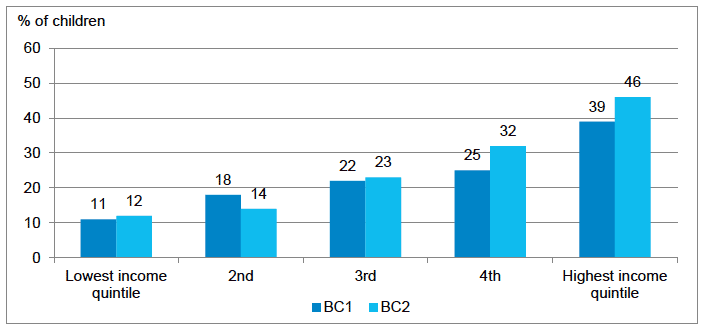
Bases: All cases where the child attended ELC and provider type information was obtained. Base sizes (unweighted/weighted): BC1= 3731/3720, BC2 = 4314/4311.
Figure 3-9 also shows that the difference by household income increased between the cohorts. For example, while the proportion of children in the lowest income group attending a private or voluntary sector provider was at almost the same level in both cohorts (11% in BC1; 12% in BC2), the proportion of children in the highest income group who attended a private or voluntary sector provider increased from 39% in BC1 to 46% in BC2.
Finally, whether children lived in urban or rural locations was also associated with the type of ELC setting they attended. In both cohorts, children living in urban areas were less likely than those living in towns or rural areas to attend local authority nursery classes attached to a primary school. Conversely, children in urban areas were more likely than children living in towns or rural areas to attend private or voluntary sector providers. [35]
Moving to quality, Figure 3-10 shows the relationship between the level of area deprivation and the proportion of children attending a setting with a high staffing quality grade for each cohort. It shows that children living in more deprived areas were less likely than their peers in less deprived areas to attend an ELC provider with 'very good' or 'excellent' staffing grades. For example, 49% of BC2 children in the most deprived quintile attended an ELC provider with at least 'very good' staffing grades compared with 62% of those in the least deprived quintile. There was no statistically significant difference in the overall relationship between area deprivation and the likelihood of a child attending an ELC provider with a high staffing quality grade between the cohorts. This means that it is not possible, on the basis of the analysis carried out here, to draw any firm conclusions about any change in this relationship between the cohorts. Nevertheless, looking at the figures there does appear to be a notable difference in the increase in the proportion of children attending a setting with high staffing quality grades according to area deprivation. Although the proportion of children attending a setting with a high staffing quality grade increased across all deprivation groups between the cohorts, it appears to have increased most in areas with the lowest levels of deprivation. [36]
Figure 3‑10 Proportion of children attending an ELC provider with 'very high' or 'excellent' staffing quality grade, by level of area deprivation ( SIMD) and by cohort
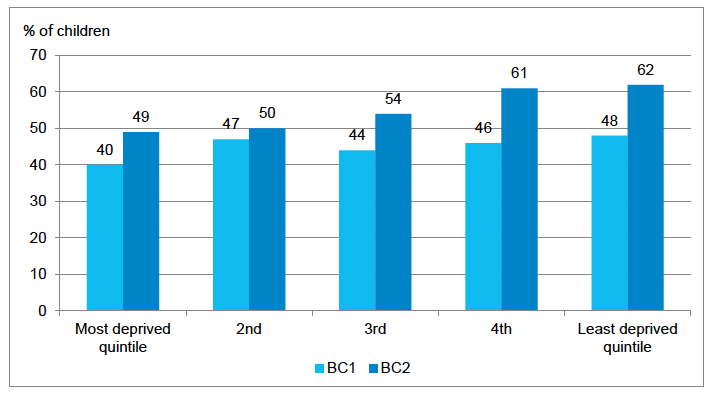
Base: All cases where the child attended ELC and where Care Inspectorate quality information was obtained. Base sizes (unweighted/weighted): BC1 = 3103/3081, BC2 = 3941/3953.
Encouragingly, the analysis showed no notable differences in the proportion of children attending ELC settings with consistently high quality grades across all four themes according to either socio-economic circumstances or location. [37] , [38] This suggests that children living in disadvantaged circumstances were just as likely as their more advantaged peers to attend an ELC provider which received 'very good' or 'excellent' grades across all themes. This was the case in both 2008/09 and 2014 and reaffirms the findings of a previous GUS report (Bradshaw et al., 2014). [39]
Contact
There is a problem
Thanks for your feedback